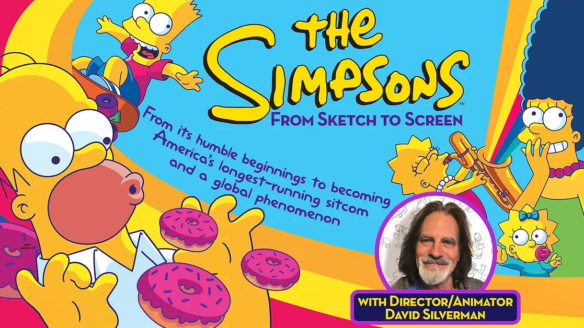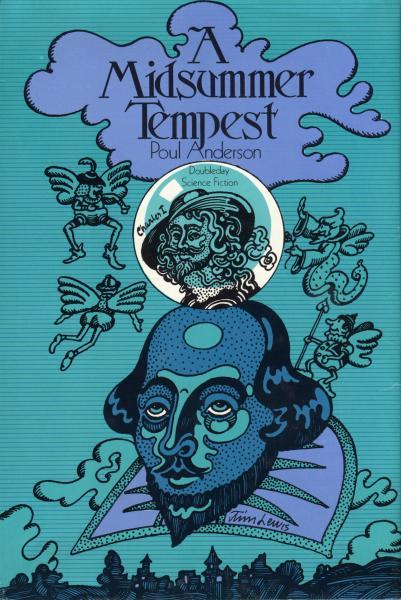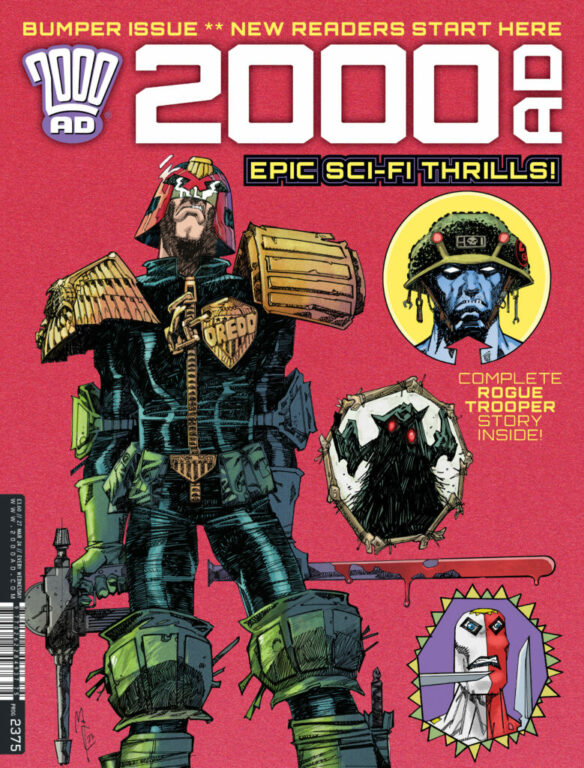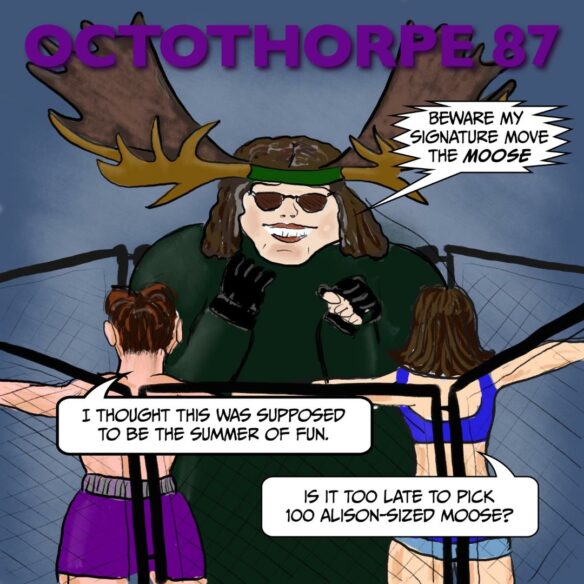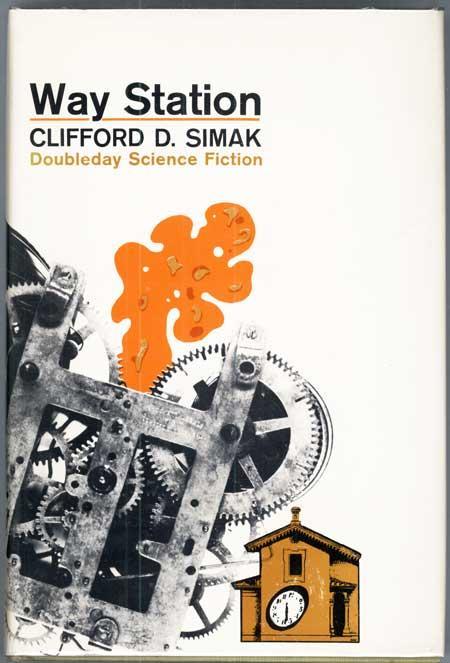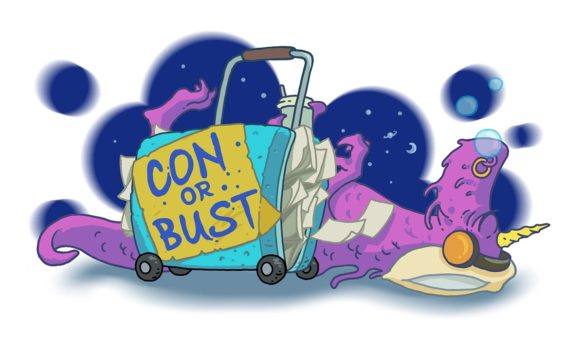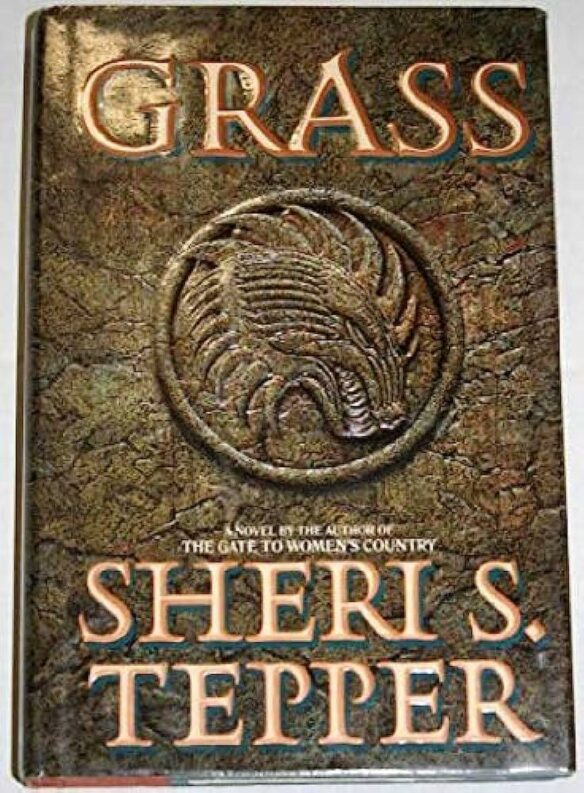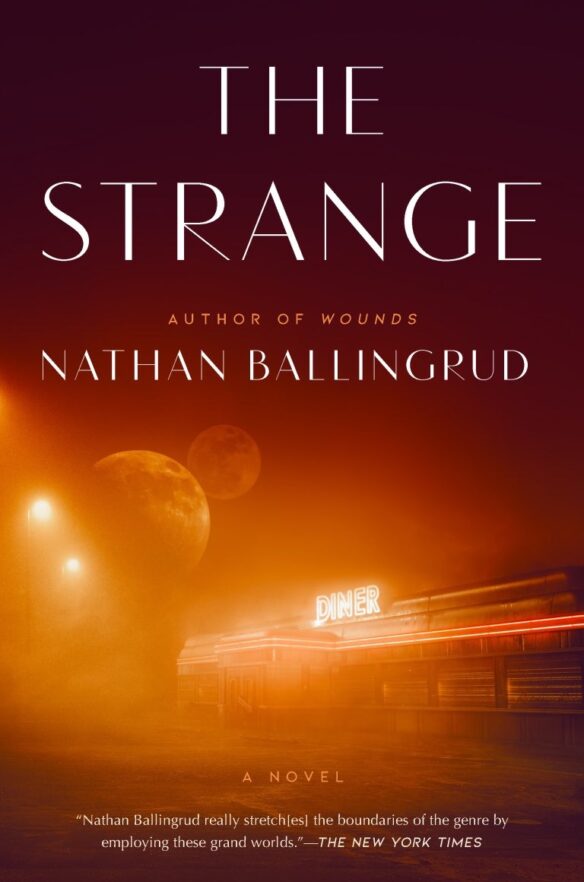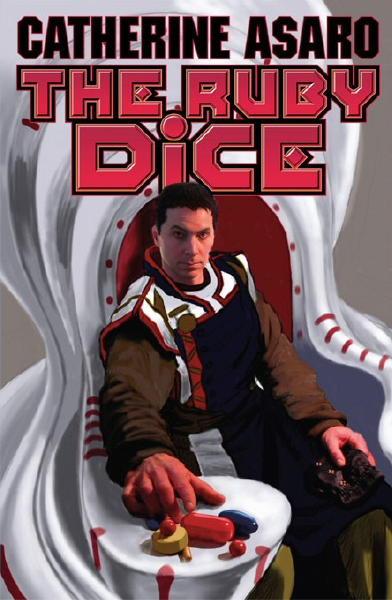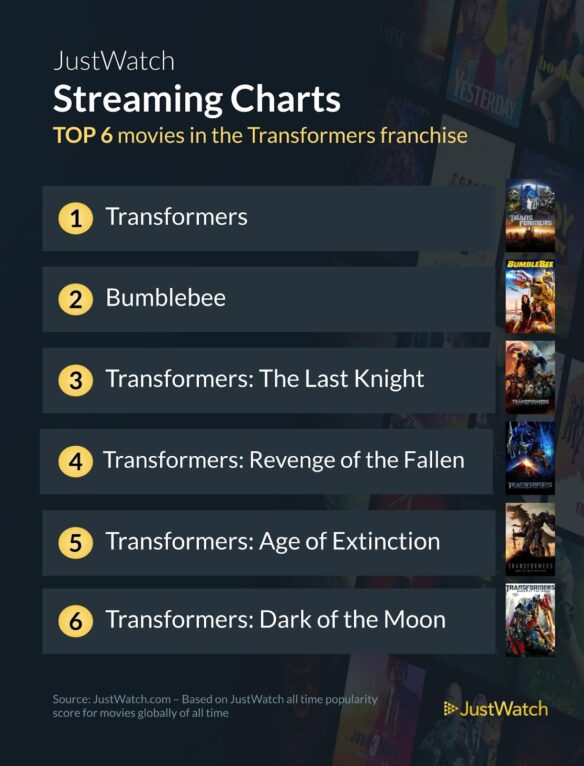(1) GAIMAN CLICKBAIT. I clicked, so you don’t have to. Despite the Variety headline – “Neil Gaiman’s The Sandman Canceled at Netflix After Season 2, Allegations” – the showrunner says Season 2 was intended to be the series’ last, and it’s apparently still going to air, so what about that is a “cancellation”?
Netflix’s adaptation of Neil Gaiman‘s “The Sandman” will end with its upcoming second season.
“The Sandman” Season 2 has been a long time coming. The first season debuted in August 2022, and it wasn’t renewed at Netflix until November of that year. At that time, Netflix was also hesitant to label it as a second season at all, choosing instead to say it was “a continuation of ‘The Sandman’ world,” and wouldn’t commit to an episode count. Variety has confirmed the second season was intended to be the last prior to filming.
“‘The Sandman’ series has always been focused exclusively on Dream’s story, and back in 2022, when we looked at the remaining Dream material from the comics, we knew we only had enough story for one more season,” “The Sandman” showrunner Allan Heinberg said in a statement to Variety Friday. “We are extremely grateful to Netflix for bringing the team all back together and giving us the time and resources to make a faithful adaptation in a way that we hope will surprise and delight the comics’ loyal readers as well as fans of our show.”…
(2) COURTHOUSE KRYPTONITE. “Warner Bros. Sued Over International Superman Rights” – The Hollywood Reporter briefs the case.
Warner Bros. Discovery has been sued over the rights to Superman in a lawsuit seeking to block the release of the studio’s tentpole film in several countries ahead of its July debut.
The estate of Joseph Shuster, the co-creator of Superman, alleges that WBD lost its international rights to the character and story years ago but continued to exploit them without its permission or compensation. In a complaint filed in New York federal court on Friday, it seeks a share of profits from all works attributable to the alleged copyright infringement — including Zack Snyder’s Justice League, Black Adam and Shazam! — in key countries such as Canada, the U.K. and Australia.
The legal action marks a potential hitch in WBD’s rollout of Superman, which arrives July 11 as the first solo movie for the character in more than a decade since Man of Steel. …
DC’s ownership of Superman dates back to 1938, when writer Jerome Siegal and Shuster, a graphic artist, sold their rights to the character and story for $130. The hero’s first appearance under DC’s banner was in Action Comics No. 1, which detailed his backstory, secret identity as newspaper reporter Clark Kent, and powers of super strength and speed (his first time flying came in 1943 in Action Comics No. 65).
Since then, it’s frequently been the target of litigation, starting in 1947 when the duo sued to invalidate DC’s ownership of the rights to Superman. The case settled, with a $94,000 payout to Shuster and Siegel to resolve the case.
Under U.S. copyright law, Shuster would typically be able to reclaim his domestic rights to Superman under a provision in intellectual property law that allows authors to claw back ownership of their works after a certain period of time. But his sister and brother reached a deal with DC in 1992 that terminated that right in exchange for $25,000 per year. A federal appeals court later upheld that determination.
This time, Shuster’s estate looks to take advantage of U.K. copyright law, which automatically terminates copyright assignments 25 years after an author’s death. By its thinking, it reclaimed the rights to Superman in 2017 since the graphic artist died in 1992.
Also at play: the possibility that Shuster’s sister didn’t have the authority to bind the estate to the agreement that purportedly surrendered its right to terminate DC’s ownership of Superman. In that case, the court stated that the issue is a “complex one” and punted on deciding it.
The lawsuit claims infringement of copyright laws in the U.K. Australia, Canada and Ireland….
(3) SCUTTLEBUTT. “Disney’s Star Wars hotel jumps from deep space to office space” – The Verge explains what that means.
Disney’s extraordinarily expensive Star Wars hotel isn’t coming back. The building that housed the Galactic Starcruiser is being converted into office space, scuppering hopes that it could be reborn or repurposed into a new interactive attraction.
The Wrap reports that the hotel will be converted into an office for Walt Disney Imagineering, the creative arm of the company responsible for its theme parks, retail, and cruise ships. The team located there will reportedly work on upcoming expansions for Florida’s Walt Disney World resort, including a Latin American section of the Animal Kingdom and a Monsters Inc. area within Hollywood Studios.
Galactic Starcruiser was an immersive hotel experience set in the Star Wars universe, where the minimum stay cost $4,800 for two people over two nights. It opened in March 2022 but ran for just a year and a half, shutting in September 2023. It returned to headlines in May 2024 when YouTuber and theme park superfan Jenny Nicholson’s four-hour video on its “spectacular failure” went viral, amassing 11 million views…
(4) IT’S PEOPLE! Inverse reviews Companion: “The Wildest Sci-Fi Thriller Of The Year Flips The Killer Robot Movie On Its Head”. BEWARE SPOILERS.
It’s a tale as old as time: boy meets girl, boy falls in love with girl, girl turns out to be a killer robot. Except Companion isn’t exactly the typical take on the classic sci-fi horror story. Instead, Drew Hancock’s cleverly constructed sci-fi horror movie is a fun takedown of the AI cautionary tale we know so well. And in the process, it may have given us the most sneakily feminist social horror movie this side of Gone Girl….
…The reason it all works, aside from Hancock’s admirably deft script, is because of Sophie Thatcher’s wonderfully malleable performance as Iris. Right off the bat, we sense that something is off with Iris — she’s a little too demure, a little too smiley, a little too doe-eyed. However, Thatcher seeds in tiny human quirks that spark some recognition for us: the way her mouth twitches uncomfortably when Josh’s friend Kat (Megan Suri) treats her with contempt, the way she glances down sadly when Josh brushes her off, and, of course, the way she would do anything to survive. By the time Companion drops its robot reveal (which again, happens very early on), we’re already primed to root for Iris, even as she starts to accumulate quite the body count….
(5) AFROFUTURIST SHORT FICTION. The Black Fantastic: 20 Afrofuturist Stories edited by andré m. carrington will be released in bookstores on February 4, and is available immediately from Library of America.
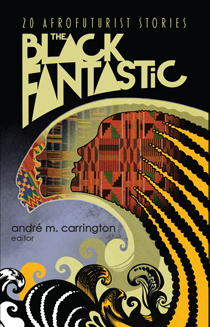
Inspired by Afrofuturist pioneers like Octavia E. Butler and Samuel R. Delany, a new generation of Black writers is fashioning a renaissance in speculative fiction. Edited and introduced by SF expert andré m. carrington, The Black Fantastic brings together Hugo, Locus, Nebula, Bram Stoker, Tiptree/Otherwise, and World Fantasy Award winners with emerging voices to showcase this watershed moment in American literature.
Here are twenty beguiling, unsettling, and visionary stories spanning the cosmos and a dazzling array of alternate timelines. Phenderson Djèlí Clark and Alaya Dawn Johnson stare down the specters of history in their haunting fictions, set, respectively, on a Founding Father’s brutal plantation and in the vampire-built internment camps of a dystopian Hawai‘i. Violet Allen’s would-be superhero stories turn to searing metafiction when her main character is repeatedly shot and killed by the police. Nana Kwame Adjei-Brenyah and Rion Amilcar Scott explore otherworldly forces at play in a small-town barbershop and in a young writer’s ambitions, while Victor LaValle tells the story of a man living on the streets of New York City, his bag of deposit bottles and cans bearing urgent messages from another dimension.
Other stories are by turns comic, provocative, and terrifying: Thaddeus Howze delivers a crowd-pleasing tall tale about a battle with aliens over the fate of Earth, by way of an epic baseball game; Maurice Broaddus spins a coming-of-age fantasy about an American girl in a utopian future Africa; Craig Laurance Gidney offers a Lovecraftian tour of the ballroom drag scene; Tara Campbell weaves a spell of ecofeminist horror; and much more.
Reimagining the past and laying claim to the future, these writers are bringing forth kaleidoscopic new visions of Black identity and creative freedom.
(6) POWER COUPLE. At One Geek’s Mind, John Grayshaw puts a spotlight on Edmond Hamilton and Leigh Brackett with the help of a Luna Monthly interview from 1975: “Interview about Edmond Hamilton and Leigh Brackett”. (The well-known sff writers wed in the 1940s; Ray Bradbury was Hamilton’s best man.) The interview touches on many different fandoms: classic movies, Star Wars, sff books, and comic books. As well as what it was like for female writers in the Forties.
Wesley Grubb: Edmond Hamilton is one of those bridge-authors, who began writing before the “Golden Age” and continued to write into the “New Wave” era. How well did his writing develop, and how well did his stories mature, from his early career compared to his later career in the 50s and 60s?
In a 1975 interview with Luna Monthly, Hamilton talked about how quickly he was writing stories back in the pulp era. He said:
“How do I feel about the rapid, high-production way we oldtime pulp writers employed in our work? I can’t speak for others, but for me it was the best way in the world to work. I might have been a more polished writer had I worked in more leisurely fashion, but I might too have been the centipede who didn’t know which leg to lift first.
One of the most ghastly stories I ever wrote was “Outside the Universe,” a wild tale of three galaxies at war. I wrote that in 1928, over 50,000 words of it first draft. I used a very small portable typewriter on a big, flat-top inherited desk. In writing those hectic space-battles, my hard pounding made the little typewriter creep all over the desk, and I would stand up and follow it in my burning enthusiasm.”
(7) THEY CAME FROM MILES AROUND. “Rebecca Yarros’s ‘Onyx Storm’ Is the Fastest-Selling Adult Novel in 20 Years” – the New York Times covers a personal appearance by the author, with quotes and comments by several of the fans on hand. (Link bypasses the paywall.)
….When Yarros became a fixture on the best-seller list, with the release of “Fourth Wing,” she had already published around 20 contemporary romance novels. But sales from book to book were largely stagnant, and she struggled with a chronic illness, Ehlers-Danlos syndrome, a genetic connective tissue disorder.
Her illness, though debilitating at times, inspired her to write “Fourth Wing,” she said. Yarros grew up loving fantasy, but had never read a fantastical novel with a protagonist who had physical limitations like she did. She decided to write about a young woman named Violet, who enrolls in an elite military academy for dragon riders, and is determined to succeed despite a chronic illness that makes her weak and physically frail….
…Fans’ fervor was palpable at the event, which was held in a huge auditorium in St. Paul. Many in the crowd were dressed up in sweatshirts, T-shirts and hats that said “Basgiath War College,” the military academy of the series. Some were fully decked out in costume, dressed as Violet, in leather body armor, or as dragons….
…At the start of the event, Yarros was introduced by the romance writer Abby Jimenez, who noted that the Empyrean series had taken over the top three slots on the New York Times best-seller list.
Yarros uttered an expletive to express her surprise and gratitude. “Thank you,” she said to the crowd. “You guys did that.”
(8) GRUMPY BUT NOT DOPEY. The star of this event is rather less thrilled to be there than the celeb in the previous item. “Grumpy Harrison Ford, a mystery asterisk and AI gone wild: everything from Disney’s new slate presentation” in the Guardian.
There are moments in life when you expect to be confronted by greatness: hearing a live orchestra swell into the opening notes of John Williams’ Star Wars theme; standing at the edge of the Scottish Highlands; watching a dog somehow open a fridge and retrieve a beer for its owner. And then there are moments when greatness sneaks up on you in the form of an 82-year-old Hollywood legend, materialising like a grumpy mirage, one metre from your face, during what you thought was a routine Disney presentation of new movies and TV shows.
Harrison Ford is not a man one simply stumbles upon. He is a force of nature, a living relic of an era when leading men didn’t have to spend six months on a chicken-and-rice diet before taking their shirts off. And yet, here he is, looking suitably nonplussed with the entire concept of being on a stage, fielding questions alongside his Captain America: Brave New World co-stars in an impromptu Q&A with all the enthusiasm of a guy who somehow finds himself trapped in the world’s most boring hostage video….
…The assembled audience is also treated to an exclusive clip of the new film, out 14 February, in which we already know Ford will end up transforming into the Red Hulk. It’s an action-packed set piece in which Wilson (Anthony Mackie) infiltrates an enemy base, and showcases the new winged Captain America suit, which we’re told was given to Sam by those helpful Wakandans. . Marvel has always been a franchise built on increasingly wobbly physics, but even the most generous audience might struggle to believe that a bloke with no serum and no billionaire gadgets could stand toe-to-toe with a bad guy whose brain is so large it requires its own postcode….
(9) JOHN ERWIN (1936-2025). “John Erwin Dead: ‘He-Man,’ ‘Archie’ Voice Actor Was 88” – The Hollywood Reporter summarizes his career —
John Erwin, the reclusive actor who provided the voices for the heroic title character in He-Man and the Masters of the Universe and the vain frenemy Reggie Mantle in a series of Archie cartoons, has died. He was 88.
Erwin died of natural causes “around Dec. 20” in his home in Camarillo, California, his reps at the PR firm Celebworx announced.
For nearly a decade starting in 1969, Erwin was heard in dozens of TV commercials as the snarky Morris the Cat, the finicky orange tabby who would eat nothing but the 9Lives brand of cat food. The hugely successful campaign was created by the Leo Burnett advertising firm.
…For Filmmation, Erwin voiced the blond, muscular He-Man (and his alter ego, Prince Adam) on He-Man and the Masters of the Universe from 1983-85 and on She-Ra: Princess of Power from 1985-87. He also played the villain Beast Man and other secondary characters on the syndicated shows that were based on a line of Mattel toys….
(10) MEMORY LANE.
[Written by Cat Eldridge.]
Roger Zelazny’s This Immortal
Fifty-nine years at Tricon where Isaac Asimov was Toastmaster, Roger Zelazny’s This Immortal won the Hugo for Best Novel in a tie with Frank Herbert’s Dune.
It was first published as “…And Call Me Conrad” in The Magazine of Fantasy and Science Fiction in October and November 1965, then as This Immortal in 1966 by Ace Books, and in 1967 by UK publisher Hart-Davis in hardcover.
So it was only in the magazine that it had that title? So why the name change? Marketing having one of their not so genius ideas?
Algis Budrys in Galaxy Bookshelf was fond of this novel saying it was “an extremely interesting and undeniably important book” with “a story of adventures and perils that is utterly charming and optimistic.”

(11) COMICS SECTION.
- Dinosaur Comics pictures imagination.
(12) COPYRIGHT OFFICE RELEASES ANOTHER PAPER ON AI. “New Government Report Addresses ‘Copyrightability’ of AI Works” – Publishers Weekly gives a quick rundown. (Download the full report here.)
The U.S. Copyright Office has released the second installment of what is envisioned as a three-part report on copyright and artificial intelligence. The most recent release addresses the issue of “copyrightability of outputs generated by AI systems.” Its recommendations are based on the comments the Copyright Office received after it posted a Notice of Inquiry in August 2023 seeking public input on the full range of copyright issues raised by AI.
Based on an analysis of copyright law and policy and comments from the public, the Copyright Office made the following conclusions and recommendations:
- Questions of copyrightability and AI can be resolved pursuant to existing law, without the need for legislative change.
- The use of AI tools to assist rather than stand in for human creativity does not affect the availability of copyright protection for the output
- Copyright protects the original expression in a work created by a human author, even if the work also includes AI-generated material
- Copyright does not extend to purely AI-generated material, or material where there is insufficient human control over the expressive elements
- Whether human contributions to AI-generated outputs are sufficient to constitute authorship must be analyzed on a case-by-case basis
- Based on the functioning of current generally available technology, prompts do not alone provide sufficient control
- Human authors are entitled to copyright in their works of authorship that are perceptible in AI-generated outputs, as well as the creative selection, coordination, or arrangement of material in the outputs, or creative modifications of the outputs
- The case has not been made for additional copyright or sui generis protection for AI generated content
(13) EATING THE FANTASTIC. Scott Edelman invites listeners to “Munch on pepper chicken masala with Larry Hama” in Episode 246 of the Eating the Fantastic podcast.
I’ve known writer/editor/artist Larry Hama for at least half a century now, but his career started long before that, when he sold his first cartoon to Castle of Frankenstein magazine in 1966. He’s probably best known as a writer and editor for Marvel Comics, where he wrote the licensed comic book series G.I. Joe: A Real American Hero, based on the Hasbro toy line, writing nearly every issue of the book’s 13-year run.

He’s also written for the series Wolverine, Nth Man: The Ultimate Ninja, and Elektra. He worked as an editor at both DC and Marvel, and at the latter edited the humor magazine Crazy, as well as Conan, The ‘Nam, and Peter Porker, The Spectacular Spider-Ham. He co-created the character Bucky O’Hare, who not only appeared in comic books, but as a television cartoon. Last year, he was inducted into the Harvey Awards Hall of Fame.
We discussed how cataract surgery changes the way an artist perceives the page, what really happened at a mid-’70s penthouse comic book party, Bernie Krigstein’s anger at being asked questions about comics, why Wally Wood felt it was so important for his assistants to learn how to letter, what it was like being part of the famed Crusty Bunkers inking collective, why getting to edit Crazy was the fulfillment of a lifelong dream, which Marvel Comics Bullpenner was the visual inspiration for Obnoxio the Clown, why getting his freelancers to hit their deadlines was never a hassle, the editing advice Archie Goodwin gave him early on, the real reason he needed to create that famous silent issue of G. I. Joe, the differing zeitgeists of Marvel vs. DC during the ’70s, his approach to taking over the editing of legacy characters, our joint confusion over memes of previous generations, and much more.
(14) TODAY’S THING TO NOT WORRY ABOUT? “Asteroid 2024 YR4 Could Strike Earth, Researchers Say, But the Odds are Small” in the New York Times (bypasses paywall).
You may hear about a large asteroid headed toward Earth. Don’t panic.
Just after Christmas Day, astronomers spotted something zipping away from Earth: a rock somewhere between 130 feet and 330 feet long that they named 2024 YR4. Over the next few weeks, they simulated its possible future orbits. They now say, based on the most up-to-date information, that there is a 1.3 percent chance that this asteroid will strike somewhere on Earth on Dec. 22, 2032.
Should this keep you up at night?
“No, absolutely not,” said David Rankin, a comet and asteroid spotter at the University of Arizona.
The object’s current odds of striking Earth may sound scary — and it’s fair to say that an asteroid in this size range has the potential to cause harm. Should it strike a city, the damage would not cause anything close to a mass extinction, but the damage to the city itself would be catastrophic.
But a 1.3 percent chance of a hit is also a 98.7 percent chance of a miss. “It’s not a number you want to ignore, but it’s not a number you need to lose sleep over,” Mr. Rankin said….
(15) A LONG WAY FROM THE BEACH. [Item by Mike Kennedy.] The roads must roll. Or the sand must flow, anyway. Meet the Dune Express, the second-longest conveyor belt in the world. At 42 miles in length, it’s built to take the place of trucks in moving sand from a quarry to an oil field where it’s used in fracking.
The Dune Express is the Texas-sized, if risky, baby of Atlas Energy Solutions. And, yes, the company is named after that book. “The World’s Second-Longest Conveyor Belt Comes to West Texas” in Texas Monthly.
I rapped my knuckles on the galvanized aluminum exterior to make sure it wasn’t some sort of desert mirage. It was solid: $400 million worth of concrete, electronics, and steel assembled to rotate a thick rubber belt along roughly 66,000 metal rollers. Something on the order of 13 million tons of sand can be carried the entire length of the machine—42 miles—each year. If all of that were used to build sandcastles, you could have a couple of dozen the size of Buckingham Palace, with more than enough left over for a Taj Mahal.
But this sand isn’t for beachside amusement. It’s for fracking. When drillers crack open subterranean rock in the Permian Basin to allow oil to flow out, sand rides alongside the injected fluid to prevent the spider’s web of new fractures from closing up again. Each grain of sand functions like a tiny support beam in a minuscule mine shaft. Fracking a single well can consume more than four hundred truckloads of sand…
(16) ELIXIR OF YOUTH. [Item by SF Concatenation’s Jonathan Cowie.] They say change is good, but I am totally with Sheldon Cooper in that it rarely is… And now we have under-reported news that could really shake things up for the planet…!
One of science’s greatest successes/failures is that the technology it spawns has benefited humanity so well that our global population has soared from a billion in 1804 to two billion in 1927 to 8 billion in 2024! The resulting pollution, the loss of wildlife habitat to agriculture, is disrupting the Earth system… And if that was not bad enough, now comes news that we may soon have a drug that can significantly (by a decade) extend human life spans….!
Yes, you read that correctly: ‘life extension’! Our planet’s population could soar? Inequality could increase?
The news was reported in this week’s issue of Nature. It seems that injecting old mice with an RNA molecule seems to reverse some signs of ageing – helping them to live longer, regrow hair and maintain their physical and mental abilities.
They used mice aged between 20 and 25 months, which is akin to between about 60 and 70 in human years. They went on to live for about 4.5 months longer, on average. They regrew hair that had become sparse, maintained a higher body weight, could stay balanced on a rotating rod for longer and had better grip strength for their weight
Now, don’t get too excited/worried just yet as the mouse may not be a good model for humans when it comes to RNA treatment, however this is still something of a breakthrough…
Primary research here.

[Thanks to Teddy Harvia, Mike Kennedy, Andrew Porter, John Grayshaw, John King Tarpinian, Chris Barkley, Cat Eldridge, SF Concatenation’s Jonathan Cowie, Steven French, and Kathy Sullivan for some of these stories. Title credit belongs to File 770 contributing editor of the day Cat Eldridge.]











